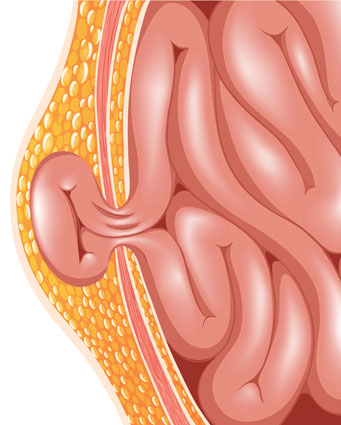 An unusual bulge in the lower abdomen can cause severe pain and embarrassment, but doctors at the University of Alabama at Birmingham are on a mission to educate and treat patients one hernia at a time.
An unusual bulge in the lower abdomen can cause severe pain and embarrassment, but doctors at the University of Alabama at Birmingham are on a mission to educate and treat patients one hernia at a time.
A hernia is a common medical condition that happens when part of an internal organ or tissue pushes through a weak area of muscle, creating a bulge. It is caused by a combination of muscle weakness and straining, like lifting something heavy. Most hernias occur in the abdomen, between the chest and the hips, and they can develop in men, women and children. Some people are born with weak abdominal muscles and therefore may be more likely to develop a hernia. The most common treatment for a hernia is surgery to repair the opening in the muscle wall. Untreated hernias tend to keep growing, often causing pain and health problems.
“Every year, nearly 700,000 Americans have surgery for groin hernias,” said Abhishek Parmar, M.D., assistant professor in the Division of Gastrointestinal Surgery. “On top of that, 350,000 Americans have surgery for ventral abdominal hernias.”
Parmar says all people have strong tissue that holds the intestines and vital organs in; but when a hole forms, those organs can sometimes start to poke through.
Who is at risk?
Britney Corey, M.D., assistant professor in the Division of Gastrointestinal Surgery, says that, if a person has ever had a prior incision or operation in the abdominal area, they are at a higher risk for developing a hernia.
“Any factors that put increased pressure on those areas like obesity, pregnancy, or factors that weaken your tissues or decrease wound healing, such as diabetes and nicotine use, will increase your risk,” Corey said. “And sometimes people form hernias and we just don’t know why.”
Corey says that, if someone is pregnant and develops a hernia, individualized care is recommended, with surgery typically put on hold until after pregnancy.
“Future pregnancies may put the hernia repair at risk,” she said.
Types of hernias:
- Inguinal (groin) hernias are the most common type of hernia and are seen much more often in men than in women. They occur in the groin area, in a part of the abdominal wall known as the inguinal canal.
- Ventral hernias can occur in nearly any part of the abdominal wall. One of the most common types of ventral hernia is the incisional hernia, which develops from incisions in the abdominal muscles, such as those made during a surgical procedure. Incisional hernias commonly appear near surgical scars, where the muscle and tissue underneath are weakened.
- Parastomal hernias develop near the site of a stoma, which is a hole created in the body by a surgeon to allow urine and other bodily waste to be collected in a pouch outside of the body. Stomas usually are created in response to a disease or infection in the digestive system, to help it heal. However, stomas also weaken the muscles in the abdominal wall, which can lead to a parastomal hernia.
- Hiatal hernias are small openings in the diaphragm that allow the stomach or other organs to move up into the chest.
- Umbilical hernias occur near the belly button and usually are harmless. They are most common in infants but can affect adults too.
Getting treatment
Parmar says treating patients with hernias is like having a chess match. It takes a thoughtful approach to think about the downstream effects.
“The real art of hernia care at UAB is that we really try to keep the whole picture in mind and consider how hernia surgery might affect a patient, not just immediately, but for the rest of their life,” he said. “We consider the whole patient and, with the help of many other doctors, try to give patients the best chances of succeeding with surgery. That’s one of the benefits of being at an academic institution like UAB.”
Once diagnosed with a hernia, patients are often referred or self-refer to a surgeon. After scheduling surgery, patients typically receive a regional block for pain control. Many procedures are done laparoscopically or robotically, which are both minimally invasive, decreasing recovery time. Post-surgery, patients may stay in the hospital for a few days or go home the same day of the procedure.
“Patients usually can resume normal activities with lifting restrictions for two to six weeks,” Corey said.
To learn more about hernias or to schedule an appointment with a UAB physician, visit the UAB HealthFinder website.
